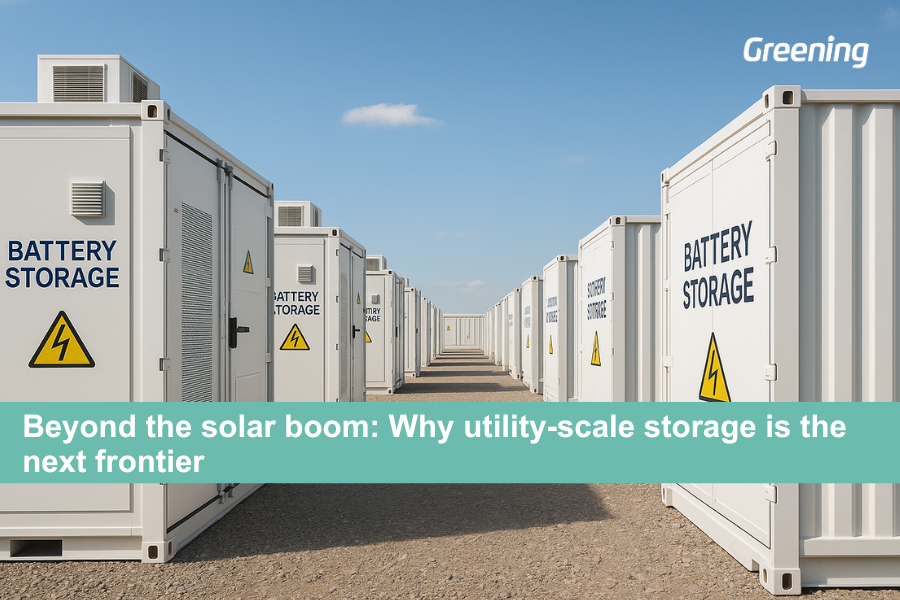The U.S. renewable energy industry is in a constant fast-paced movement. After a decade dominated by record-breaking solar growth, the next great leap in clean energy isn’t about adding more panels; it’s about storing their power. Utility-scale battery storage is emerging as the cornerstone of the modern grid, transforming the way our country generate, distribute, and consume electricity.

From Generation to Optimization
For years, the conversation around renewables centered on capacity: how many megawatts could be installed and how quickly. That narrative is evolving. As the U.S. grid integrates unprecedented volumes of intermittent generation, reliability and flexibility have become the new benchmarks of progress.
As mentioned in our last newsletter, Battery Energy Storage Systems (BESS) provide that flexibility. They absorb excess solar and wind generation during low-demand hours and discharge it when the grid needs it most, stabilizing voltage, preventing curtailment, and reducing dependence on fossil-fueled peakers. In short, storage converts clean energy from a variable resource into a controllable asset.
According to the U.S. Department of Energy (DOE), “energy storage is the key to unlocking the full potential of renewable energy: ensuring that clean power is available not just when the sun shines or the wind blows, but whenever consumers need it.”
Market momentum and scale
The Energy Information Administration (EIA) projects that installed utility-scale battery capacity in the U.S. will more than triple by 2030, reaching over 80 gigawatts. California and Texas: two markets with vastly different policy frameworks, are leading the charge, proving that economics, not just regulation, are driving the growth.
In its 2025 report, Wood Mackenzie notes that declining lithium-ion costs (down over 80% since 2013) and improved project economics have made storage a mainstream investment category. The firm highlights that “utility-scale batteries are now being deployed as integral components of generation portfolios, not as pilot projects.”
But this growth is not simply quantitative. The role of storage in power markets is becoming multidimensional: offering services such as frequency regulation, energy arbitrage, capacity firming, and transmission deferral. This value stack is what makes utility-scale storage so strategically compelling: it delivers technical reliability and financial returns simultaneously.
The strategic value of storage
Beyond megawatts and megawatt-hours, the real value of storage lies in its strategic contribution to energy markets.
- It enhances grid resilience, supporting frequency and voltage regulation.
- It enables energy arbitrage, capturing low-price energy and selling during high-demand peaks.
- It reduces curtailment, allowing developers to maximize solar and wind utilization.
- And it offers capacity value, providing dependable backup when generation dips.
As SEIA President Abigail Ross Hopper recently emphasized, “Energy storage is no longer a nice-to-have: it’s an essential pillar of the clean energy economy.”
Utility-scale batteries are also proving critical to regional grid stability. In ERCOT, for instance, large BESS projects have helped stabilize supply during heat waves and unplanned generation outages. Similarly, California’s ISO now regularly relies on multi-hour batteries to meet evening ramp demands: a role traditionally filled by gas turbines.

Strategic Economics and Policy in the energy transition
The economics are compelling. While battery prices remain influenced by global supply chains and materials costs, advances in chemistry (such as LFP and emerging sodium-ion technologies) continue to improve cost-effectiveness and lifespan.
At the policy level, the Inflation Reduction Act (IRA) of 2022 was a milestone, introducing standalone storage tax credits that catalyzed an influx of investment and project announcements. Yet, as the market matures, developers are looking beyond incentives, focusing instead on optimizing revenue streams and grid services that ensure long-term financial sustainability.
According to the International Energy Agency (IEA), the world will need to add over 1,500 GW of battery storage by 2050 to meet global net-zero targets. The United States, with its combination of advanced markets, supportive regulation, and private investment, is expected to lead a substantial share of that deployment.
Redefining project value
For decades, renewable success was measured in installed capacity: how much could be built, and how fast. Now, success is measured in system intelligence: how efficiently that capacity is integrated, balanced, and monetized.
Utility-scale storage represents that shift. It transforms renewable projects into dynamic energy systems capable of delivering firm, dispatchable power and economic stability. For utilities, it offers a hedge against volatility. For grid operators, it provides a stabilizing anchor. For investors, it opens a diversified revenue model that extends far beyond energy sales.
In this sense, storage is not a supporting technology: it’s the foundation of a flexible, decentralized, and resilient grid.
Looking ahead
As we move past the solar boom, the next chapter of the U.S. energy transition will be defined by how effectively we can manage what we’ve built. Storage is the bridge between generation and reliability, ambition and deliverability, sustainability and economic sense.
The question is no longer if utility-scale storage will lead the next phase of growth: it’s how fast we can deploy it.
The energy market tomorrow will be measured not only by how much clean power we generate, but by how intelligently we store, manage, and deploy it. That’s the true promise, and power, of utility-scale storage.
At Greening, we believe storage is not just the next step, it’s the enabler of a fully renewable future.
Learn more about how we’re developing and integrating utility-scale storage solutions across the U.S.
Contact us!

